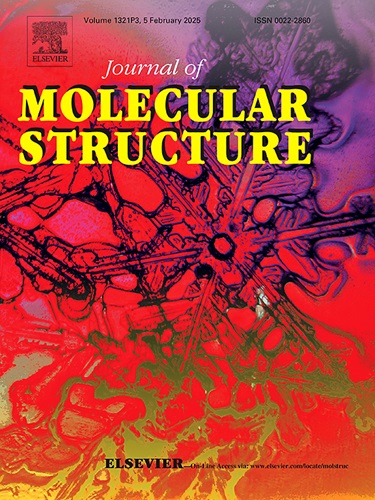基于DFT和分子对接的新型蒽醌类席夫碱Cu(II)、Ru(III)和VO(II)配合物的合成、光谱分析、理化研究和生物医学潜力
IF 4
2区 化学
Q2 CHEMISTRY, PHYSICAL
引用次数: 0
摘要
合成了四齿状席夫碱配体2-[(5-溴-2-羟基苄基)氨基]-1-(2-氧-1,2-二氢吲哚-3-基氨基)蒽醌(BOA)的4种新型Cu(II)、Ru(III)和VO(II)配合物。采用元素分析、磁性测量、傅里叶变换红外光谱、电子能谱、摩尔电导率测量等方法测定了这些配合物的化学计量比和理化性质。利用亚甲基的氮原子和氧原子,光谱研究表明,合成的希夫碱配体,称为BOA,与铜(II),钌(III)和钒(IV)氧化物金属中心建立了配合物。BOA-Cu和BOA-Ru配合物具有八面体几何形状,而BOA-VO配合物具有方锥体几何形状。通过连续变化和摩尔比分析的结果验证了M:L比,揭示了1:1的最佳组成。pH谱显示,所测配合物的pH稳定性范围广(pH = 4-10)。为了补充实验结果,采用密度泛函理论(DFT)分析了合成配合物的电子结构和化学反应性。理论研究提供了优化后的分子几何形状、前沿轨道(HOMO和LUMO)能级、能隙和关键反应性参数的见解。这些计算结果支持了所提出的配合物的配位模式和结构稳定性。同时,还进行了分子对接研究,以预测配体及其金属配合物与与抗菌和抗癌活性相关的特定生物靶点的相互作用潜力。特别是BOA-Ru复合物,在选定的靶蛋白的活性位点内表现出很强的结合亲和力和稳定的相互作用,与其优越的生物学性能相一致。这些计算见解强化了实验结果,表明boa衍生金属配合物具有良好的治疗潜力。一项创新的研究评估了最近合成的希夫碱配体及其相应的金属化合物在体外抑制各种细菌病原体和真菌增殖的功效,旨在为开发针对这些有害微生物的先进治疗剂做出贡献。结果表明,与基准药物氧氟沙星和氟康唑相比,BOA-Ru复合物成为最普遍的抑制剂,具有优越的抗菌效果。此外,一项研究评估了一种创新分子及其后续化合物在受控环境下的细胞杀伤特性,针对Hep-G2、MCF-7和HCT-116癌细胞系,以确定其对抗恶性肿瘤的功效。配合物的比较清楚地表明,与阿霉素相比,BOA-Ru作为活性成分表现出更大的功效。此外,该配体及其金属配合物的抗氧化潜能通过标准自由基清除试验进行了评估。结果表明,BOA-Ru配合物表现出最高的抗氧化活性,这可能是由于其给电子能力增强和配位框架稳定所致。本文章由计算机程序翻译,如有差异,请以英文原文为准。

Synthesis, spectral analysis, physicochemical investigation and biomedical potential of some novel Cu(II), Ru(III) and VO(II) complexes with anthraquinone-based Schiff base supported by DFT and molecular docking insights
Four novel Cu(II), Ru(III) and VO(II) complexes of tetra-dentate Schiff base ligand 2-[(5-Bromo-2-hydroxy-benzylidene)-amino]-1-(2-oxo-1,2-dihydro-indol-3-ylideneamino) anthraquinone(BOA) were synthesized. Elemental analyses, magnetic measurements, FT-IR, electronic spectra, molar conductivity measurements were used to measure the stoichiometric ratios and physiochemical properties of these complexes. Utilizing the nitrogen and oxygen atoms from the azomethine group, the spectroscopic study demonstrated that the synthesized Schiff base ligand, referred to as BOA, established coordination complexes with copper(II), ruthenium(III), and vanadium(IV) oxide metal centers. BOA-Cu and BOA-Ru complexes have octahedral geometry while BOA-VO complex has square pyramidal geometry. The M:L ratio was validated through the outcomes of both continuous variation and molar ratio analyses, revealing an optimal composition of 1:1. The pH profile revealed that the wide range of pH stability of the tested complexes (pH = 4-10). To complement the experimental findings, Density Functional Theory (DFT) analyses were employed to explore the electronic structure and chemical reactivity of the synthesized complexes. The theoretical investigations provided insights into the optimized molecular geometries, energy levels of the frontier orbitals (HOMO and LUMO), energy gaps, and key reactivity parameters. These computational outcomes supported the proposed coordination modes and structural stability of the complexes. In parallel, molecular docking studies were carried out to predict the interaction potential of the ligand and its metal complexes with specific biological targets relevant to antimicrobial and anticancer activities. The BOA-Ru complex, in particular, demonstrated strong binding affinities and stable interactions within the active sites of selected target proteins, aligning with its superior biological performance. These computational insights reinforce the experimental results, indicating promising therapeutic potential for the BOA-derived metal complexes. An innovative study evaluated the in vitro efficacy of a recently synthesized Schiff base ligand and its corresponding metal compounds in suppressing the proliferation of various bacterial pathogens and fungi aiming to contribute to the development of advanced therapeutic agents against these harmful microbes. The results indicated that, in contrast to the benchmark medications Ofloxacin and Fluconazole, the BOA-Ru complex emerged as the most prevalent inhibitor, exhibiting superior antimicrobial efficacy. Moreover, an investigation assessed the cell-killing properties of an innovative molecule and its subsequent compounds in a controlled environment, targeting Hep-G2, MCF-7, and HCT-116 cancerous cell lines to ascertain their efficacy in combating malignancy. The comparison of complexes clearly indicated that BOA-Ru exhibits greater efficacy as an active component in contrast to Doxorubicin. Furthermore, the antioxidant potential of the ligand and its metal complexes was evaluated using standard radical scavenging assays. The results revealed that the BOA-Ru complex exhibited the highest antioxidant activity, likely due to its enhanced electron-donating ability and stable coordination framework.
求助全文
通过发布文献求助,成功后即可免费获取论文全文。
去求助
来源期刊

Journal of Molecular Structure
化学-物理化学
CiteScore
7.10
自引率
15.80%
发文量
2384
审稿时长
45 days
期刊介绍:
The Journal of Molecular Structure is dedicated to the publication of full-length articles and review papers, providing important new structural information on all types of chemical species including:
• Stable and unstable molecules in all types of environments (vapour, molecular beam, liquid, solution, liquid crystal, solid state, matrix-isolated, surface-absorbed etc.)
• Chemical intermediates
• Molecules in excited states
• Biological molecules
• Polymers.
The methods used may include any combination of spectroscopic and non-spectroscopic techniques, for example:
• Infrared spectroscopy (mid, far, near)
• Raman spectroscopy and non-linear Raman methods (CARS, etc.)
• Electronic absorption spectroscopy
• Optical rotatory dispersion and circular dichroism
• Fluorescence and phosphorescence techniques
• Electron spectroscopies (PES, XPS), EXAFS, etc.
• Microwave spectroscopy
• Electron diffraction
• NMR and ESR spectroscopies
• Mössbauer spectroscopy
• X-ray crystallography
• Charge Density Analyses
• Computational Studies (supplementing experimental methods)
We encourage publications combining theoretical and experimental approaches. The structural insights gained by the studies should be correlated with the properties, activity and/ or reactivity of the molecule under investigation and the relevance of this molecule and its implications should be discussed.
 求助内容:
求助内容: 应助结果提醒方式:
应助结果提醒方式:


